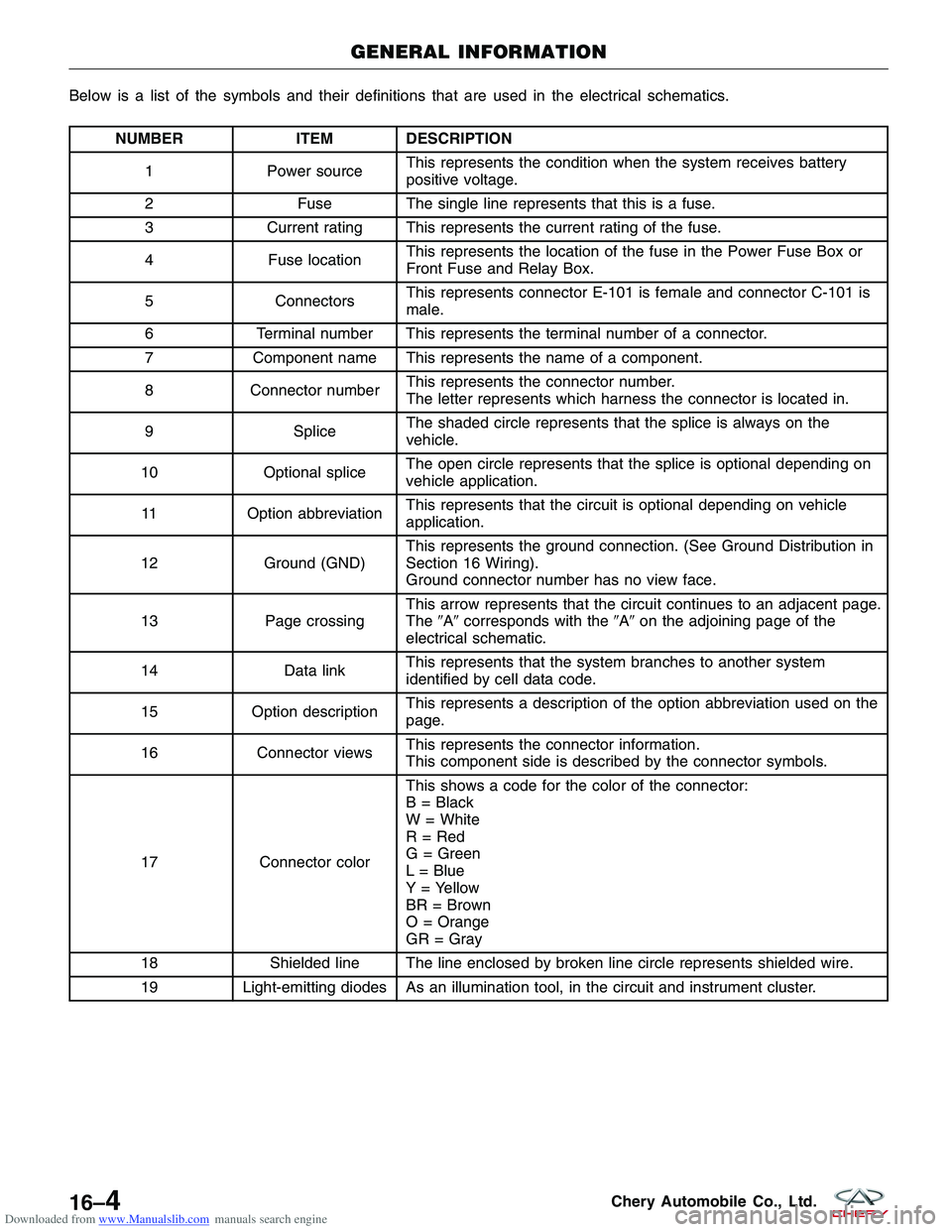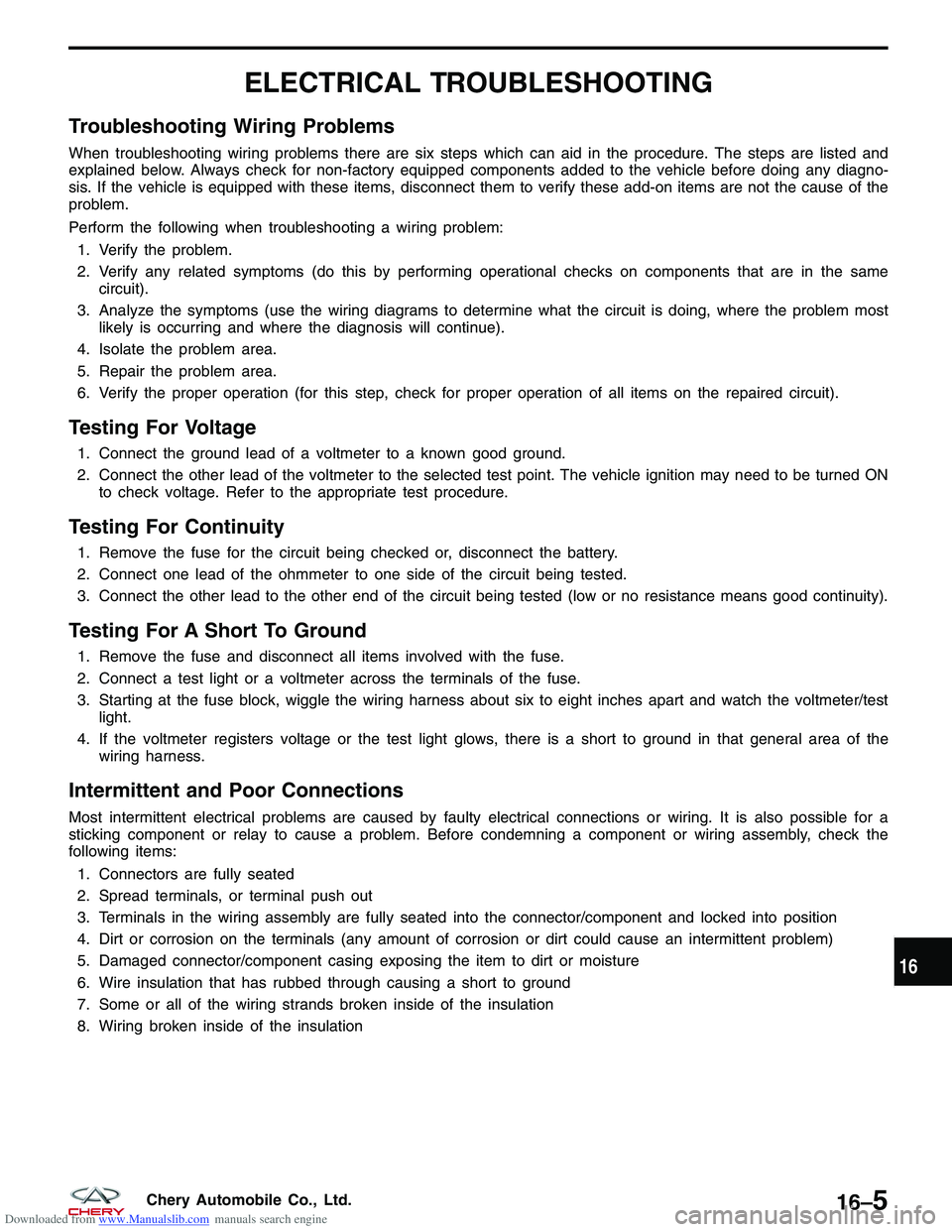Page 1830 of 1903

Downloaded from www.Manualslib.com manuals search engine Below is a list of the symbols and their definitions that are used in the electrical schematics.
NUMBERITEM DESCRIPTION
1 Power source This represents the condition when the system receives battery
positive voltage.
2 Fuse The single line represents that this is a fuse.
3 Current rating This represents the current rating of the fuse.
4 Fuse location This represents the location of the fuse in the Power Fuse Box or
Front Fuse and Relay Box.
5 Connectors This represents connector E-101 is female and connector C-101 is
male.
6 Terminal number This represents the terminal number of a connector.
7 Component name This represents the name of a component.
8 Connector number This represents the connector number.
The letter represents which harness the connector is located in.
9 Splice The shaded circle represents that the splice is always on the
vehicle.
10 Optional splice The open circle represents that the splice is optional depending on
vehicle application.
11 Option abbreviation This represents that the circuit is optional depending on vehicle
application.
12 Ground (GND) This represents the ground connection. (See Ground Distribution in
Section 16 Wiring).
Ground connector number has no view face.
13 Page crossing This arrow represents that the circuit continues to an adjacent page.
The
�A�corresponds with the �A�on the adjoining page of the
electrical schematic.
14 Data linkThis represents that the system branches to another system
identified by cell data code.
15 Option description This represents a description of the option abbreviation used on the
page.
16 Connector views This represents the connector information.
This component side is described by the connector symbols.
17 Connector color This shows a code for the color of the connector:
B = Black
W = White
R = Red
G = Green
L = Blue
Y = Yellow
BR = Brown
O = Orange
GR = Gray
18 Shielded line The line enclosed by broken line circle represents shielded wire.
19 Light-emitting diodes As an illumination tool, in the circuit and instrument cluster.
GENERAL INFORMATION
16–4Chery Automobile Co., Ltd.
Page 1831 of 1903

Downloaded from www.Manualslib.com manuals search engine ELECTRICAL TROUBLESHOOTING
Troubleshooting Wiring Problems
When troubleshooting wiring problems there are six steps which can aid in the procedure. The steps are listed and
explained below. Always check for non-factory equipped components added to the vehicle before doing any diagno-
sis. If the vehicle is equipped with these items, disconnect them to verify these add-on items are not the cause of the
problem.
Perform the following when troubleshooting a wiring problem:1. Verify the problem.
2. Verify any related symptoms (do this by performing operational checks on components that are in the same circuit).
3. Analyze the symptoms (use the wiring diagrams to determine what the circuit is doing, where the problem most likely is occurring and where the diagnosis will continue).
4. Isolate the problem area.
5. Repair the problem area.
6. Verify the proper operation (for this step, check for proper operation of all items on the repaired circuit).
Testing For Voltage
1. Connect the ground lead of a voltmeter to a known good ground.
2. Connect the other lead of the voltmeter to the selected test point. The vehicle ignition may need to be turned ON to check voltage. Refer to the appropriate test procedure.
Testing For Continuity
1. Remove the fuse for the circuit being checked or, disconnect the battery.
2. Connect one lead of the ohmmeter to one side of the circuit being tested.
3. Connect the other lead to the other end of the circuit being tested (low or no resistance means good continuity).
Testing For A Short To Ground
1. Remove the fuse and disconnect all items involved with the fuse.
2. Connect a test light or a voltmeter across the terminals of the fuse.
3. Starting at the fuse block, wiggle the wiring harness about six to eight inches apart and watch the voltmeter/testlight.
4. If the voltmeter registers voltage or the test light glows, there is a short to ground in that general area of the wiring harness.
Intermittent and Poor Connections
Most intermittent electrical problems are caused by faulty electrical connections or wiring. It is also possible for a
sticking component or relay to cause a problem. Before condemning a component or wiring assembly, check the
following items:
1. Connectors are fully seated
2. Spread terminals, or terminal push out
3. Terminals in the wiring assembly are fully seated into the connector/component and locked into position
4. Dirt or corrosion on the terminals (any amount of corrosion or dirt could cause an intermittent problem)
5. Damaged connector/component casing exposing the item to dirt or moisture
6. Wire insulation that has rubbed through causing a short to ground
7. Some or all of the wiring strands broken inside of the insulation
8. Wiring broken inside of the insulation
16
16–5Chery Automobile Co., Ltd.
Page 1835 of 1903
Downloaded from www.Manualslib.com manuals search engine ELECTRICAL COMPONENTS
Battery Cable
•Before disconnecting connectors or removing elec-
trical parts, disconnect the negative battery cable.
Sensors, Switches, and Relays
•Handle sensors, switches and relays carefully. Do
not drop them or strike them against other objects.
LTSMW170001
BESM010024
16
16–9Chery Automobile Co., Ltd.
Page 1839 of 1903
Downloaded from www.Manualslib.com manuals search engine GENERAL INFORMATION
Description
The power distribution system is designed to provide safe, reliable, centralized and convenient access to the distri-
bution of the electrical power required to operate all vehicle electrical and electronic systems.
The following components are used for power distribution:
•Battery
• Power Fuse Box
• Body Fuse and Relay Box
• Front Fuse and Relay Box
• Ignition Switch
• Fuses
• Circuit Breakers
• Relays
Operation
The power distribution system operates all electrical and electronic engine, transmission, chassis, safety, comfort and
convenience systems.
16
16–13Chery Automobile Co., Ltd.
Page 1863 of 1903
Downloaded from www.Manualslib.com manuals search engine VEHICLE FUSE BOX INFORMATION
GENERAL INFORMATION16-38
Description 16-38
Operation 16-38
Power Fuse Box 16-38
Description 16-38
Operation 16-38
Overview 16-39 Front Fuse and Relay Box
16-40
Description 16-40
Operation 16-40
Overview 16-41
Body Fuse and Relay Box 16-42
Description 16-42
Operation 16-42
Overview 16-43
16
16–37Chery Automobile Co., Ltd.
Page 1864 of 1903

Downloaded from www.Manualslib.com manuals search engine GENERAL INFORMATION
Description
In order to ensure the normal operation of the system, every electrical system is equipped with fuses and relays. The
fuses and relays are stored in the fuse boxes.
The vehicle fuses and relays are located in the following locations:
•Power Fuse Box
• Front Fuse and Relay Box
• Body Fuse and Relay Box
Operation
When replacing a open fuse, it is important to use only a fuse having the correct amperage rating. The use of a fuse
with a rating other than indicated may result in a dangerous electrical system overload. If a properly rated fuse con-
tinues to open, it indicates a problem in the circuit that must be corrected.
Power Fuse Box
Description
The power fuse box is located on the side of the battery. All of the electrical current distributed throughout the vehicle
is directed through the power fuse box. The power fuse box houses five maxi-type bolt in fuses.
Operation
All of the current from the battery and the generator output enters the power fuse box through the cable and eyelet
that are secured with a nut to the power fuse box B(+) terminal stud located on one end of the power fuse box
housing. The power fuse box terminal stud cover is unlatched and opened to access the fuses.
16–38Chery Automobile Co., Ltd.
Page 1866 of 1903
Downloaded from www.Manualslib.com manuals search engine Front Fuse and Relay Box
Description
The front fuse and relay box houses many of the fuses and relays for the vehicles electrical system. The front fuse
and relay box is located on the right side of the engine compartment and under the cowl top of windshield. If the
fuses and relays cannot be serviced, it must be replaced as a unit.
Operation
When a circuit fails, the fuse will blow and remove current from the circuit. The front fuse and relay box is equipped
with a label that identifies each component. The label is printed on the inside of the cover. The power fuse box
identifies the rating of each fuse individually. Turn off the ignition switch, and then replace the fuse.
GENERAL INFORMATION
16–40Chery Automobile Co., Ltd.
Page 1867 of 1903
Downloaded from www.Manualslib.com manuals search engine Overview
Front Fuse And Relay Box
GENERAL INFORMATION
LTSMW170005T
16
16–41Chery Automobile Co., Ltd.